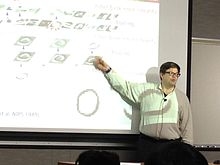Yann LeCun
| Yann LeCun | |
|---|---|
 |
|
| Born | July 8, 1960 |
| Institutions |
New York University Facebook Artificial Intelligence Research |
| Alma mater | Pierre and Marie Curie University |
| Thesis | Modeles connexionnistes de l'apprentissage (connectionist learning models) (1987) |
| Doctoral advisor | Maurice Milgram |
| Known for | Deep learning |
|
Website yann |
|
Yann LeCun (born 1960) is a computer scientist and primarily a neuronetologist with contributions in machine learning, computer vision, mobile robotics and computational neuroscience. He is well known for his work on optical character recognition and computer vision using convolutional neural networks (CNN), and is a founding father of convolutional nets. He is also one of the main creators of the DjVu image compression technology (together with Léon Bottou and Patrick Haffner). He co-developed the Lush programming language with Léon Bottou.
Yann LeCun was born near Paris, France, in 1960. He received a Diplôme d'Ingénieur from the Ecole Superieure d'Ingénieur en Electrotechnique et Electronique (ESIEE), Paris in 1983, and a PhD in Computer Science from Université Pierre et Marie Curie in 1987 during which he proposed an early form of the back-propagation learning algorithm for neural networks. He was a postdoctoral research associate in Geoffrey Hinton's lab at the University of Toronto.
In 1988, he joined the Adaptive Systems Research Department at AT&T Bell Laboratories in Holmdel, New Jersey, United States, headed by Lawrence D. Jackel, where he developed a number of new machine learning methods, such as a biologically inspired model of image recognition called Convolutional Neural Networks, the "Optimal Brain Damage" regularization methods, and the Graph Transformer Networks method (similar to conditional random field), which he applied to handwriting recognition and OCR. The bank check recognition system that he helped develop was widely deployed by NCR and other companies, reading over 10% of all the checks in the US in the late 1990s and early 2000s.
...
Wikipedia
